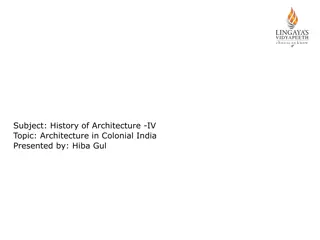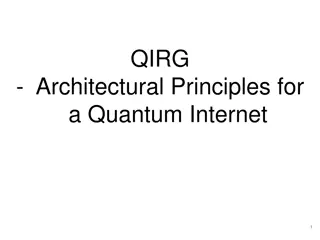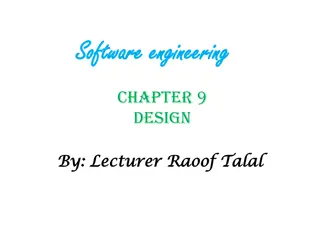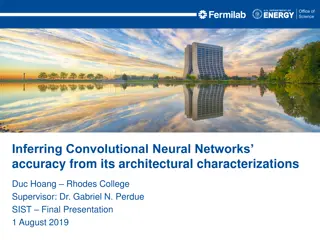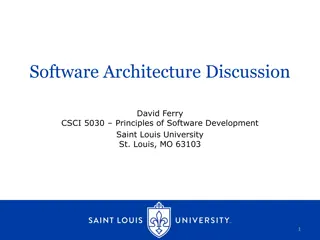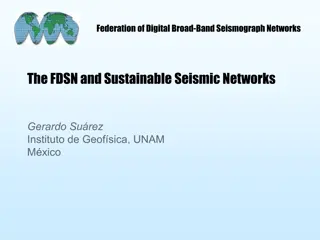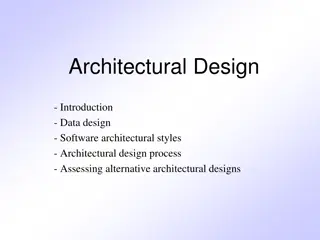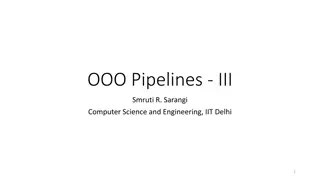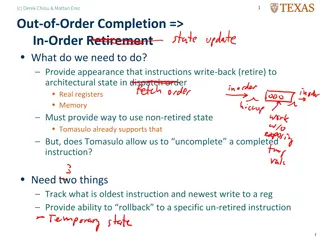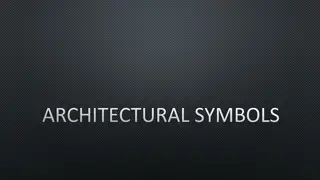Broad Architectural Principles in System Design
The role of broad architectural principles in system design is crucial for creating large-scale systems. Researchers must define goals and assumptions while considering performance, elegance, and iterative design processes. Understanding critical-path driven processes helps optimize system efficiency and functionality, as shown in the development of a fast multicast system like Horus.
Download Presentation

Please find below an Image/Link to download the presentation.
The content on the website is provided AS IS for your information and personal use only. It may not be sold, licensed, or shared on other websites without obtaining consent from the author.If you encounter any issues during the download, it is possible that the publisher has removed the file from their server.
You are allowed to download the files provided on this website for personal or commercial use, subject to the condition that they are used lawfully. All files are the property of their respective owners.
The content on the website is provided AS IS for your information and personal use only. It may not be sold, licensed, or shared on other websites without obtaining consent from the author.
E N D
Presentation Transcript
THE ROLE OF BROAD ARCHITECTURAL PRINCIPLES IN SYSTEMS CS6410 Ken Birman
Creation of a large system A complex undertaking Researchers often get to define the goals and assumptions at the same time as they architect the solution: Many areas completely lack standards or prior systems Many standards are completely ignored Many widely adopted systems depart from the relevant standards Are there overarching goals that all systems share?
Candidate goals All systems should strive for the best possible performance given what they are trying to do But of course the aspects of performance one measures will depend on the use case(s) envisioned Aiming for performance in a way that ignores use cases can yield a misleading conclusion A system should be an elegant expression of the desired solutions and mechanisms Puzzle: What metrics capture the notion of elegance?
First steps in the design process Developers often work in an iterative way Identify and, if possible, separate major considerations Pin down the nature of the opportunity they see, and from this refine their goals and assumptions Eventually, begin to conceive of system in terms of an architectural block diagram with (more or less) well- defined components and roles for each Walking through the main code paths may lead to redesigns that aim at optimizing for main use cases
Critical-path driven process If we can identify common patterns or use cases a- priori (or perhaps by analysis of workloads from other similar systems for which data exists)... Permits us to recognize in advance that particular code paths will arise often and will really determine performance for the metrics of primary interest In effect we can distort our design to support very short critical paths at the expense of shifting functionality elsewhere, off the critical path This sometimes permits us to use less optimized logic off the critical path without fear of huge performance hits
Example: Van Renesse (Horus) Robbert was developing a fast multicast system Core functionality: Reliable multicast from some sender to some set of receivers The particular system, Horus, implements the same virtual synchrony model we discussed last week Virtual synchrony platforms inevitably require a lot of logic to deal with complexities of the real-world But how much of that logic needs to be on the critical path for common operations?
Robbert adopted a layered approach User sees some primitive like g.SafeSend(...) SafeSend uses an internal infrastructure, perhaps to obtain a snapshot of the group view, with a list of current members, locking the group against membership changes until SafeSend completes g.Send(m) Deliver(m) NewView(v) Add/Del members Horus Layer Below this is a layer doing reliable sending, flow control and retransmission within a set of members Idea: Standard layers Like Legotm blocks Each supports the identical interface Below this is a layer establishing connections Below this one that discovers IP addresses...
Horus protocol: Stack of microprotocols Not every layer has work to do with respect to every event SafeSend Basic model: events that flow up, or down By standardizing he ended up with a kind of mix-and-match protocol architecture Reliable Send View Snapshot Total Ordering Physical Multicast
Elegant... but what about efficiency? Robbert s stacks often had 15 or 20 microprotocols By rearranging and changing selection he could build many kinds of higher level protocols in a standard way But many microprotocols just passed certain kinds of event through, taking no action of their own Performance reflected very high overheads when he microbenchmarked his solution Isolate a component, then run billions of events through
Critical path analysis Robbert realized that his architecture would be evaluated heavily in terms of throughput and delay Delay measured from when g.SafeSend was invoked until when delivery occurs Throughput: g.SafeSend completions per second All of that pass-through untouched logic on the critical path slows Horus down
Drilling down What does the code inside a Horus layer do? Robbert had the idea of classifying the instructions into three categories Logic that could run before ever seeing the message Logic that needs to see the actual message (cares about the bytes inside, or a sequence number, etc) Logic that could run after the message is send
Horus layers and sub-layers Steps in running a layer 1 Prepare 2 Touch Message 3 PostProcessing 4 Send 5 6 Do they need to happen in this order?
Horus layers and sub-layers Send before post-processing, then prepare for next 1 Touch Message 2 Send 3 PostProcessing 5 Prepare Prepare 0 6 4 (Scheme makes an optimistic guess that next event will be a multicast, runs unprepare if guess was wrong)
Success! Horus broke all records for multicast performance and Robbert got a great SIGCOMM publication Masking the Overhead of Layering. Robbert van Renesse. Proc. of the 1996 ACM SIGCOMM Conf. Stanford University. August 1996. Links nicely to today s theme: to what extent can we abstract the kind of reasoning we just saw into a set of general design principles that anyone could benefit from? We ll look first at the Internet level, then the O/S
End-to-End arguments in System Design Jerry H. Saltzer, David P. Reed, David D. Clark Authors were early MIT Internet researchers who played key roles in understanding and solving Internet challenges Jerry H. Saltzer A leader of Multics, key developer of the Internet, and a LAN (local area network) ring topology, project Athena David P. Reed Early development of TCP/IP, designer of UDP David D. Clark I/O of Multics, Protocol architect of Internet We reject: kings, presidents and voting. We believe in: rough consensus and running code.
End-to-End arguments in System Design Jerry H. Saltzer, David P. Reed, David D. Clark Question posed: suppose we want a functionality such as reliability in the Internet. Where should we place the implementation of the required logic? Argue for end-to-end solutions, if certain conditions hold Can the higher layer implement the functionality it needs? if yes - implement it there, the app knows its needs best Implement the functionality in the lower layer only if A) a large number of higher layers / applications use this functionality and implementing it at the lower layer improves the performance of many of them AND B) does not hurt the remaining applications
Example : File Transfer (A to B) 6. Route packet 4. Pass msg/packet down the protocol stack 5. Send the packet over the network A B 1. 2. 3. network subsystem Read File Data blocks App buffers File Data Pass (copy) data to the
Example : File Transfer 7. Receive packet and buffer msg. 8. Send data to the application A B 9. Store file data blocks
Possible failures Reading and writing to disk Transient errors in the memory chip while buffering and copying network might drop packets, modify bits, deliver duplicates OS buffer overflow at the sender or the receiver Either of the hosts may crash
Would a reliable network help? Suppose we make the network reliable Packet checksums, sequence numbers, retry, duplicate elimination Solves only the network problem. What about the other problems listed? War story: Byte swapping problem while routing @ MIT Not sufficient and not necessary
Solutions? Introduce file checksums and verify once transfer completes an end-to-end check. On failure retransmit file.
Solutions? (cont.) network level reliability would improve performance. But this may not benefit all applications Huge overhead for say Real-Time speech transmission Need for optional layers Checksum parts of the file.
Formally stated "The function in question can completely and correctly be implemented only with the knowledge and help of the application standing at the end points of the communication system. Therefore, providing that questioned function as a feature of the communication system itself is not possible. (Sometimes an incomplete version of the function provided by the communication system may be useful as a performance enhancement.)"
Other end-to-end requirements Delivery guarantees Application level ACKs Deliver only if action guaranteed 2 phase commit NACKs End-to-end authentication Duplicate msg suppression Application level retry results in new n/w level packet
TCP/IP Internet Protocol IP is a simple ("dumb"), stateless protocol that moves datagrams across the network, and Transmission Control Protocol TCP is end-to-end. It is a smart transport protocol providing error detection, retransmission, congestion control, and flow control end-to- end. The network The network itself (the routers) needs only to support the simple, lightweight IP; the endpoints run the heavier TCP on top of it when needed.
End-to-End became a religion! The principle is applied throughout the Internet in a very aggressive way Every TCP session does its own failure detection Any kind of strong consistency guarantee (like the things Isis or Horus are doing) is viewed as not part of the Internet . Routing daemons don t synchronize actions. Accounts for one of those forks in the road we discussed: SIGCOMM and SOSP/NSDI have very different styles. Contemporary puzzle: RDMA offers reliability in hardware. Not E2E yet RDMA is the big new thing
Hints for Computer System Design - Butler Lampson Related to end-to-end argument guidance for developer The paper offers a collection of experience and wisdom aimed at (operating) systems designers Suggests that they be viewed as hints, not religion Rules of thumb that can guide towards better solutions
Butler Lampson - Background Founding member of Xerox PARC (1970), DEC (1980s), MSR (current) ACM Turing Award (1992) Laser printer design PC (Alto is considered first actual personal computer) Two-phase commit protocols Bravo, the first WYSIWYG text formatting program Ethernet, the first high-speed local area network (LAN)
Some Projects & Collaborators Charles Simonyi - Bravo: WYSIWYG editor (MS Office) Bob Sproull - Alto operating system, Dover: laser printer, Interpress: page description language (VP Sun/Oracle) Mel Pirtle - 940 project, Berkeley Computer Corp. Peter Deutsch - 940 operating system, QSPL: system programming language (founder of Ghostscript) Chuck Geschke, Jim Mitchell, Ed Satterthwaite - Mesa: system programming language
Some Projects & Collaborators (cont.) Roy Levin software configuration - Wildflower: Star workstation prototype, Vesta: Andrew Birrell, Roger Needham, Mike Schroeder - Global name service and authentication Eric Schmidt - System models: software configuration (CEO/Chairman of Google) Rod Burstall - Pebble: polymorphic typed language
Hints for Computer System Design - Butler Lampson
Functionality Interface Contract separates implementation from client using abstraction Eg: File (open, read, write, close) Desirable properties Simple Complete Admit small and fast impl.
Simplicity Interfaces Avoid generalizations too much = large, slow and complicated impl. Can penalize normal operations PL/1 generic operations across data types Should have predictable (reasonable) cost. eg: FindIthField [O(n)], FindNamedfield [O(n^2)] Avoid features needed by only a few clients
Functionality Vs Assurance As a system performs more (complex interface) assurance decreases.
Example Tenex System reference to an unassigned page -> trap to user program arguments to sys calls passed by reference CONNECT(string passwd) -> if passwd wrong, fails after a 3 second delay CONNECT for i := 0 to Length(directoryPassword) do if directoryPassword[i] != passwordArgument[i] then Wait three seconds; return BadPassword end if end loop; connect to directory; return Success
Breaking CONNECT(string passwd) Unassigned Page Assigned Page A B Bad Passwd Invalid page
Breaking CONNECT(string passwd) Worst case Unassigned Page Assigned Page 128*n tries as opposed to 128^n tries n = passwd length (bytes) B A Z Bad Passwd Invalid page
Functionality (cont.) basic (fast) operations rather than generic/powerful (slow) ones Pay for what you want RISC Vs CISC Unix Pipe grep i 'spock' * | awk -F: '{print $1}' | sort | uniq | wc l Use timing tools (80% of the time in 20% of code) Avoid premature optimization May be useless and/or expensive analyze usage and optimize heavily used I/Fs
Abstractions Avoid abstracting-out desirable properties don't hide power Eg: Feedback for page replacement How easy is it to identify desirable properties? Procedure arguments filter procedure instead of a complex language with patterns. static analysis for optimization - DB query lang failure handlers trust?
Continuity Interfaces Changes should be infrequent Compatibility issues Backward compatibility on change Implementation Refactor to achieve satisfactory (small, fast, maintainable) results Use prototyping
Implementation Keep secrets Impl. can change without changing contract Client could break if it uses Impl. details But secrets can be used to improve performance finding the balance an art? Divide and conquer Reuse a good idea in different settings global replication using a transactional model local replication for reliably storing transactional logs.
Completeness - handling all cases Handle normal and worst case separately normal case speed, worst case progress Examples caches incremental GC trace-and-sweep (unreachable circular structures) piece-table in the Bravo editor Compaction either at fixed intervals or on heavy fragmentation emergency supply helps in worst-case scenarios
Speed Split resources in a fixed way rather than share and multiplex faster access, predictable allocation Safety instead of optimality over-provisioning ok, due to cheap hardware Use static analysis where possible dynamic analysis as a fallback option Eg: sequential storage and pre-fetching based on prior knowledge of how data is accessed
Speed (cont.) Cache answers to expensive computations x, f => f(x) f is functional. Use hints! may not reflect the "truth" and so should have a quick correctness check. Routing tables Ethernet (CSMA/CD)
Speed (cont.) Brute force when in doubt Prototype and test performance Eg: linear search over a small search space Beware of scalability! Background processing (interactive settings) GC writing out dirty pages, preparing pages for replacement. Shed load Random Early Detection Bob Morris' red button
Fault Tolerance End-to-end argument Error recovery at the app level essential Eg: File transfer Log updates Replay logs to recover from a crash form 1: log <name of update proc, arguments> update proc must be functional arguments must be values form 2: log state changes. idempotent (x = 10, instead of x++) Make actions atomic Aries algorithm - Atomicity and Durability
Conclusions Every field develops a community intuition into the principles that lead towards our kind of work Solutions that are esthetically pleasing and reflect sound reasoning But how can one communicate esthetics? And what sorts of reasoning should be viewed as sound ? For the systems area, the tensions between the hardware we work with, the problems to be solved and the fact that we create platforms that others will use weigh heavily into this analysis
Second System Syndrome In 2012 we are rarely the first people to build a given kind of system It can be hard to resist including all the usual functionality and then adding in new amazing stuff Lampson believes that elegance centers on leaving things out not including every imaginable feature! Perhaps the most debated aspect of his approach Think about Windows versus Linux (versus early Unix)
Concrete conclusions? Think back to the way Robbert approached Horus Pose your problem in a clean way Next decompose into large-scale components Think about the common case that will determine performance: the critical path or the bottleneck points Look for elegant ways to simultaneously offer structural clarity (like the Horus Legotm building blocks) and yet still offer fantastic performance This can guide you towards very high-impact success
Next Time Read and write review: The UNIX time-sharing system, Dennis M. Ritchie and Ken Thompson. Communications of the ACM Volume 17, Issue 7, July 1974, pages 365 -- 375 The Duality of Memory and Communication in the Implementation of a Multiprocessor Operating System. M. Young, A Tavanian, R. Rashid, D. Golub, and J. Eppinger. Proceedings of the Eleventh ACM Symposium on Operating Systems Principles (Austin, Texas, United States), ACM, 1987, pages 63--76.







